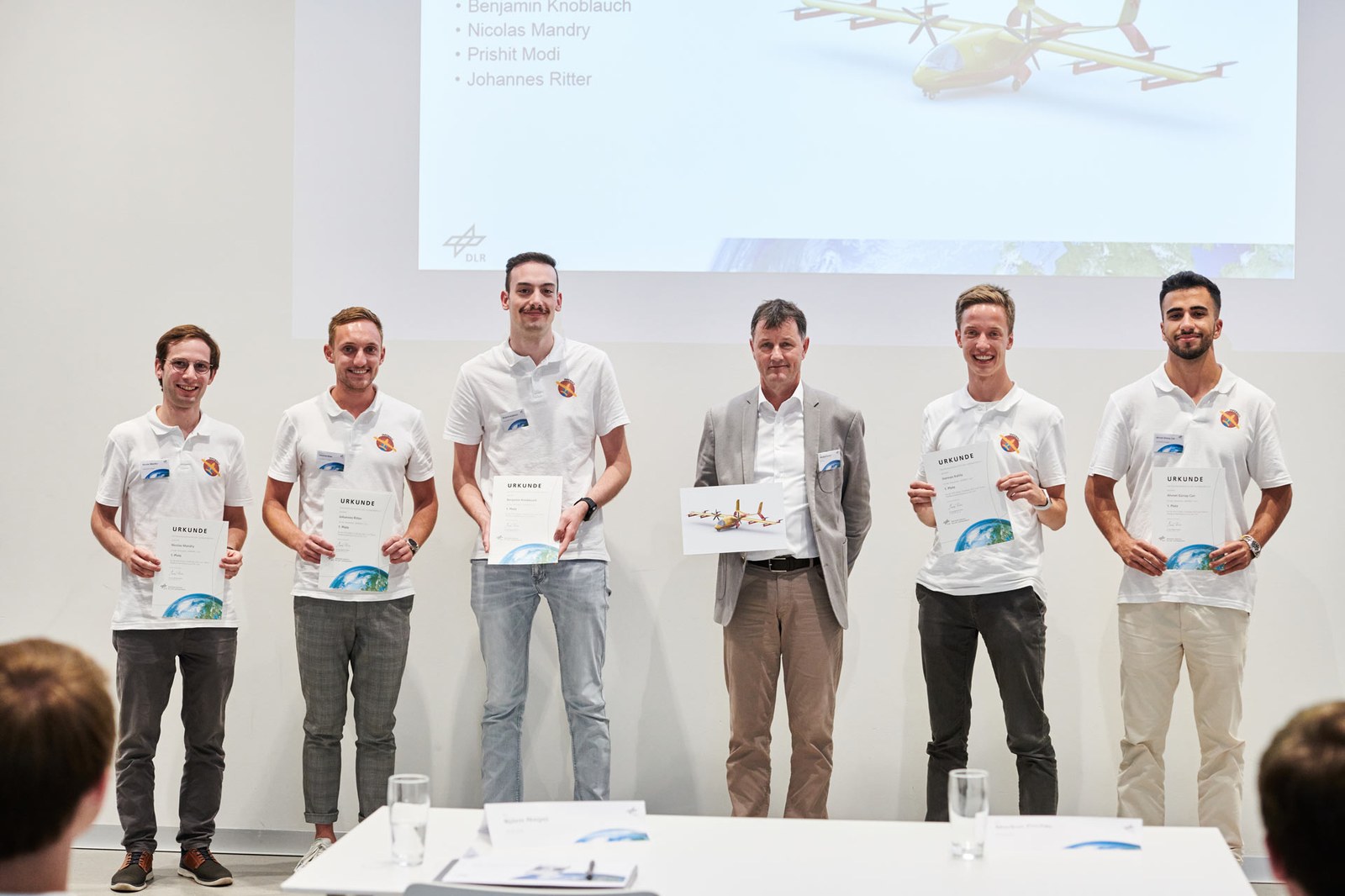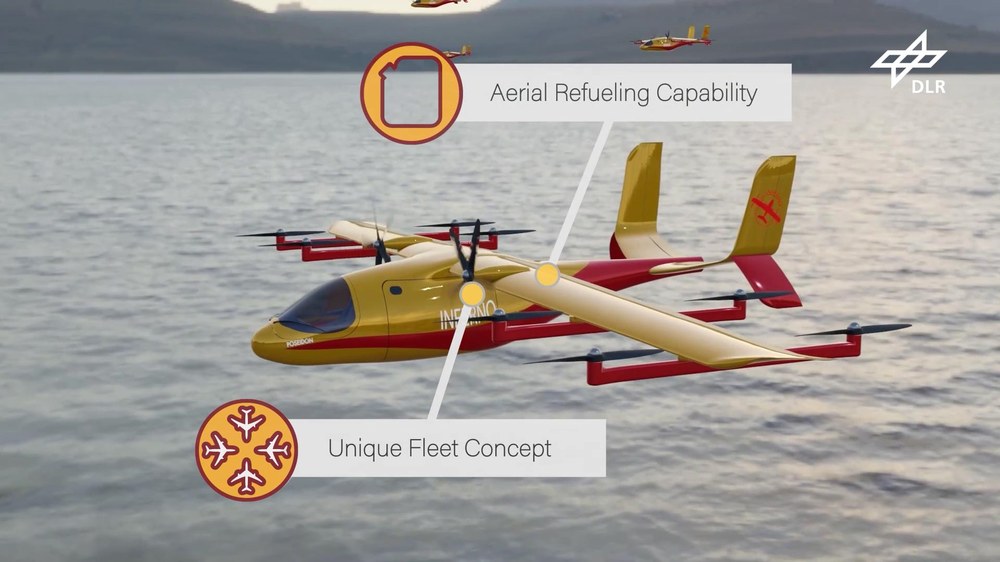INFERNO fire-fighting aircraft takes first place in the 2022 DLR Design Challenge


- Students from the University of Stuttgart impressed the DLR jury with their INFERNO concept.
- The task set for the 2022 DLR Design Challenge was to design a fleet of aircraft for systematic forest firefighting.
- Focus: Aeronautics, young researchers, climate change, forest fires
At this year’s DLR Design Challenge, the jury at the German Aerospace Center (Deutsches Zentrum für Luft- und Raumfahrt; DLR) awarded first place to the INFERNO concept by students from the University of Stuttgart. The Technical University of Dresden followed in second place with PEL-E-FAN-T, while RWTH Aachen came in third with its FireWasp concept. The risk of forest fires is increasing all over the world as a result of climate change. The task of this year’s DLR Design Challenge addressed this topic and called for a whole-system approach. The organisers wanted to see systematic designs featuring optimal interaction, both among a fleet of firefighting aircraft and with units on the ground, with the aim of maximising the amount of water transported to the fire site over a period of 24 hours. Six student teams presented their designs at the final symposium for the competition in early August 2022. The DLR Institute of System Architectures in Aeronautics in Hamburg hosted the final event for the teams.
“Current media reports on climate change and the associated increase in forest fires show us just how important it is to take action,” said Markus Fischer, DLR Divisional Board Member for Aeronautics and Chair of the DLR Design Challenge jury. “Through their engagement with the topic, the students who took part in the competition have put forward some striking ideas for what highly effective forest firefighting could look like. The winners will all have had the experience of competing as part of a team and will be able to draw upon their personal achievements within a group.”
Björn Nagel, Director of the DLR Institute of System Architectures in Aeronautics, stressed how impressed the jury were by the collaboration among the teams: “Despite the difficult circumstances due to the COVID-19 pandemic, the students presented extremely successful concepts. As a result, we have also been able to step up our work with the universities and exchange designs, ideas and inspiration.”

Video: INFERNO concept of the University of Stuttgart
Your consent to the storage of data ('cookies') is required for the playback of this video on Quickchannel.com. You can view and change your current data storage settings at any time under privacy.
© DLR / Universität Stuttgart / INFERNO
Firefighting aircraft and fleet design
The task was to design a fleet of aircraft for entry into service by 2030. Together, they needed to deliver at least 11,000 litres of water to a fire scene in a single firefighting mission. The number of aircraft and their respective payloads were left up to the teams, and this was intended to form part of the operational concept. The aircraft needed to be able to collect water from nearby water sources such as lakes, rivers or seas, and access small bodies of water or bodies of water surrounded by trees. This would require very short landing and takeoff capabilities. Every aircraft had to be able to be controlled either by a person on board, from the ground or via sophisticated automation, and be able to take off, land and scoop up water both at night and in poor visibility conditions. The aim was to maximise the amount of water transported to the scene of the fire within 24 hours. The individual aircraft were to be designed in such a way that they could also be produced as passenger or cargo transport versions. In addition to fighting forest fires, the teams also had to consider other uses for the firefighting aircraft.
This was the sixth edition of the annual Design Challenge. Due to the restrictions caused by the COVID-19 pandemic, both the kick-off event and much of the design work by the teams took place online. The challenge culminated in a final hybrid event at the Center of Applied Aeronautical Research (Zentrum für Angewandte Luftfahrtforschung; ZAL) on the DLR site in Hamburg. As a follow-up to the 2022 DLR Design Challenge, the top three teams will present their concepts at the German Aerospace Congress (DLRK 2022) in Dresden. The winning team will also present their design at the Congress of the International Council of the Aeronautical Sciences (ICAS 2022) (ICAS 2022) in Stockholm and develop it further in a DLR workshop on airborne forest firefighting.
A total of 33 students, divided into six teams from five universities, took part in the 2022 DLR Design Challenge. Thanks to digital collaboration, an inter-university team consisting of students from two universities was also able to take part for the first time. Here is a detailed rundown of the three first-place winners and the three other qualifying entries:
First place – University of Stuttgart with INFERNO
INFERNO (short for INtelligent FirE RespoNse Operation) was designed by the winning team from the University of Stuttgart. It uses eight horizontal rotors for vertical take-off and landing and two propellers for forward flight, thanks to the hybrid-electric propulsion concept powered by Sustainable Aviation Fuel (SAF). In addition to the well-known scooping method, the team also included the immersion method as a way of taking up water from small bodies of water. As INFERNO is piloted by one person on board, the team developed a detailed cockpit design for safe flying even in poor visibility and at night. INFERNO is designed to be highly modular, so it could also transport cargo or passengers. In order to make it even more effective at extinguishing flames, the operating concept provides for the possibility of aerial refuelling.
Team: Ahmet Günay Can, Hannes Kahlo, Benjamin Knoblauch, Nicolas Mandry, Prishit Modi, Johannes Ritter
Second place – TU Dresden with PEL-E-FAN-T
The PEL-E-FAN-T concept (short for proPELlor driven turbo Electric hybrid Firefighting AutoNomous vTol) from Technical University of Dresden is an uncrewed drone. The hybrid-electric propulsion architecture allows for vertical and horizontal flight. The four vertical propellers allow the drone to take off and land vertically, enabling PEL-E-FAN-T to use even very small water sources for extinguishing tasks. The design envisages the attachment of different modules beneath the fuselage, depending on the application. In fleet operations, for instance, two drones are equipped with a reconnaissance module so that they can pass on important information for the firefighting operation to the rest of the fleet. PEL-E-FAN-T can take water on board through a pumping mechanism. The team is also planning cargo and passenger modules to enable further use outside of the forest fire season.
Team: Dominik Brunner, Hannes Jerzembek, Lennard Köhler, Paul Sanderbrand, Maximilian Wenk
Third place – RWTH Aachen with FireWasp
The hybrid helicopter FireWasp from RWTH Aachen combines the positive features of helicopters and aeroplanes. Rotors and wings ensure efficient cruising at high flying speeds. The propulsion system includes a conventional gas turbine that could be operated entirely with SAFs when it is put into service in 2030. Due to the selected system architecture, FireWasp can both take off and land vertically, allowing it to take in water from very small sources using a snorkel pump. The fleet, which consists of a reconnaissance helicopter with special equipment and six other vehicles with firefighting equipment, is operated autonomously and can be remotely controlled from a mobile ground station if necessary. Due to the modular integration of the subsystems, FireWasp can also be used for freight transport, spraying pesticides and for airborne environmental monitoring.
Team: Mucahit Fatih Evliyaoglu, Selim Karakus, Dominik Kau, Robin Mörsch
Commendation – TU Dresden and TU Braunschweig with GLAROS
This aircraft configuration allows for greater cruising efficiency to accommodate larger volumes of water. To compensate for any disadvantages compared to aircraft that take off vertically, GLAROS (Greek for ‘seagull’), uses the increased uplift due to the distributed drives of the turbo-electric propulsion system to minimise the take-off distance. Two batteries and a turbo generator serve as the energy source. SAFs can be used to reduce the climate impact. As GLAROS is a remotely piloted aircraft, the team uses the 4G/5G mobile network and satellite communications for reliable control. GLAROS is a flying boat and uses the familiar scooping technique to collect water.
Team: Alejandro Antonio Arjona Reyes, Alexander Bloi, Jannis Link, Benedikt Rings, Dominik Vogt, Philipp Wilkendorf
Commendation – DHBW Ravensburg with Dipper and AEGIS
Dipper is a hybrid-electric amphibious aircraft designed by a team from DHBW Ravensburg. A simulation model was used for additional assessment and to determine the fleet requirements. A distributed electric propulsion system with six counter-rotating propellers along the wingspan and two propellers on the wing tips enhance the aerodynamic properties. This configuration means that the aircraft is capable of takeoff, landing and scooping in open water over short distances. The team designed the AEGIS software (short for Aerial Extinguishing Grouped Intervention System) for systemic fleet deployment on firefighting missions. The fleet consists of six aircraft that are remotely controlled, coordinated and monitored via AEGIS. The aircraft can also be used for transport or research in remote areas and harsh conditions, and there is potential for converting it for humanitarian missions after natural disasters.
Team: Brendan Berg, Paul Droste, Isabella Kullmer-Ispas, Magnus Schoder, Pascal Trapp, Florian Wolff
Commendation – DHBW Ravensburg with FireF(l)ighter
FireF(l)ighter from a DHBW Ravensburg team is a combination of a helicopter and an autogyro. A conventional gas turbine provides the power for both vertical flight as a helicopter and horizontal flight as an autogyro. In helicopter mode, the aircraft can take up water for firefighting from very small bodies of water surrounded by forest. The water tank at the bottom of the fuselage is filled via a suction device. By using extinguishing additives, foam carpets can assist in suppressing rekindled fires in coordination with firefighting teams on the ground. The fleet comprises ten aircraft in total, controlled by a team of people on the ground.
Team: Hannah Feiler, Hannes Loheide, Sabrina Schaible, Maren Traber, Frieder Völkle, Tristan Wiegner
Downloads
- DLR Design Challenge 2022 - Report: University Stuttgart – INFERNO - 3.13 MB (application/pdf)
- DLR Design Challenge-2022 - Report: TU Dresden – PEL-E-FAN-T - 1.37 MB (application/pdf)
- DLR Design Challenge 2022 - Report: RWTH Aachen – FireWasp - 900.58 KB (application/pdf)
- DLR Design Challenge 2022 - Report: TU Dresden und TU Braunschweig – GLAROS - 2.03 MB (application/pdf)
- DLR Design Challenge 2022 - Report: DHBW Ravensburg – Dipper & AEGIS - 1.91 MB (application/pdf)
- DLR Design Challenge 2022 - Report: DHBW Ravensburg – FireF(l)ighter - 1.01 MB (application/pdf)
- DLR Design Challenge 2022 - Help tackling the threat of wildfires! - 299.25 KB (application/pdf)






